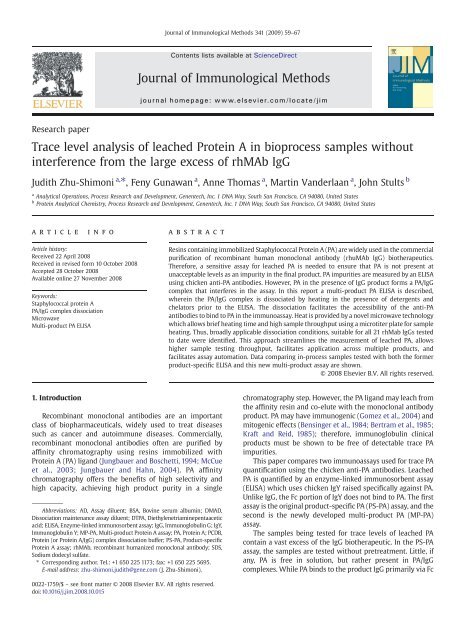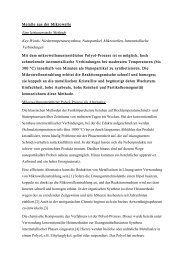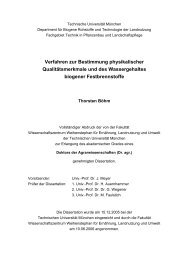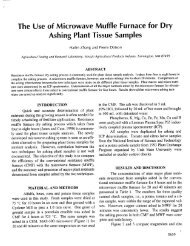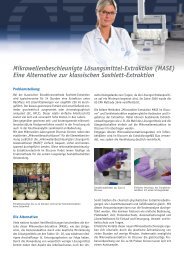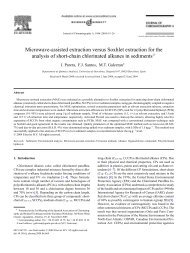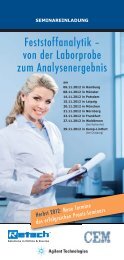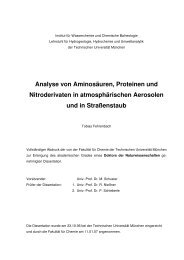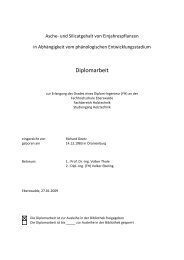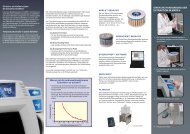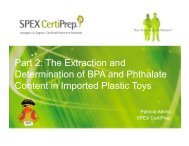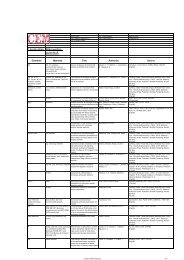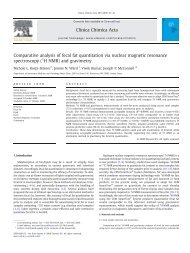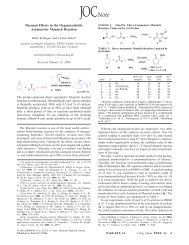Trace level analysis of leached Protein A in bioprocess samples ...
Trace level analysis of leached Protein A in bioprocess samples ...
Trace level analysis of leached Protein A in bioprocess samples ...
Create successful ePaper yourself
Turn your PDF publications into a flip-book with our unique Google optimized e-Paper software.
Research paper<br />
<strong>Trace</strong> <strong>level</strong> <strong>analysis</strong> <strong>of</strong> <strong>leached</strong> <strong>Prote<strong>in</strong></strong> A <strong>in</strong> <strong>bioprocess</strong> <strong>samples</strong> without<br />
<strong>in</strong>terference from the large excess <strong>of</strong> rhMAb IgG<br />
Judith Zhu-Shimoni a, ⁎, Feny Gunawan a , Anne Thomas a , Mart<strong>in</strong> Vanderlaan a , John Stults b<br />
a Analytical Operations, Process Research and Development, Genentech, Inc. 1 DNA Way, South San Francisco, CA 94080, United States<br />
b <strong>Prote<strong>in</strong></strong> Analytical Chemistry, Process Research and Development, Genentech, Inc. 1 DNA Way, South San Francisco, CA 94080, United States<br />
article <strong>in</strong>fo abstract<br />
Article history:<br />
Received 22 April 2008<br />
Received <strong>in</strong> revised form 10 October 2008<br />
Accepted 28 October 2008<br />
Available onl<strong>in</strong>e 27 November 2008<br />
Keywords:<br />
Staphylococcal prote<strong>in</strong> A<br />
PA/IgG complex dissociation<br />
Microwave<br />
Multi-product PA ELISA<br />
1. Introduction<br />
Recomb<strong>in</strong>ant monoclonal antibodies are an important<br />
class <strong>of</strong> biopharmaceuticals, widely used to treat diseases<br />
such as cancer and autoimmune diseases. Commercially,<br />
recomb<strong>in</strong>ant monoclonal antibodies <strong>of</strong>ten are purified by<br />
aff<strong>in</strong>ity chromatography us<strong>in</strong>g res<strong>in</strong>s immobilized with<br />
<strong>Prote<strong>in</strong></strong> A (PA) ligand (Jungbauer and Boschetti, 1994; McCue<br />
et al., 2003; Jungbauer and Hahn, 2004). PA aff<strong>in</strong>ity<br />
chromatography <strong>of</strong>fers the benefits <strong>of</strong> high selectivity and<br />
high capacity, achiev<strong>in</strong>g high product purity <strong>in</strong> a s<strong>in</strong>gle<br />
Abbreviations: AD, Assay diluent; BSA, Bov<strong>in</strong>e serum album<strong>in</strong>; DMAD,<br />
Dissociation ma<strong>in</strong>tenance assay diluent; DTPA, Diethylenetriam<strong>in</strong>epentaacetic<br />
acid; ELISA, Enzyme-l<strong>in</strong>ked immunosorbent assay; IgG, Immunoglobul<strong>in</strong> G; IgY,<br />
Immunoglobul<strong>in</strong> Y; MP-PA, Multi-product <strong>Prote<strong>in</strong></strong> A assay; PA, <strong>Prote<strong>in</strong></strong> A; PCDB,<br />
<strong>Prote<strong>in</strong></strong> (or <strong>Prote<strong>in</strong></strong> A/IgG) complex dissociation buffer; PS-PA, Product-specific<br />
<strong>Prote<strong>in</strong></strong> A assay; rhMAb, recomb<strong>in</strong>ant humanized monoclonal antibody; SDS,<br />
Sodium dodecyl sulfate.<br />
⁎ Correspond<strong>in</strong>g author. Tel.: +1 650 225 1173; fax: +1 650 225 5695.<br />
E-mail address: zhu-shimoni.judith@gene.com (J. Zhu-Shimoni).<br />
0022-1759/$ – see front matter © 2008 Elsevier B.V. All rights reserved.<br />
doi:10.1016/j.jim.2008.10.015<br />
Journal <strong>of</strong> Immunological Methods 341 (2009) 59–67<br />
Contents lists available at ScienceDirect<br />
Journal <strong>of</strong> Immunological Methods<br />
journal homepage: www.elsevier.com/locate/jim<br />
Res<strong>in</strong>s conta<strong>in</strong><strong>in</strong>g immobilized Staphylococcal <strong>Prote<strong>in</strong></strong> A (PA) are widely used <strong>in</strong> the commercial<br />
purification <strong>of</strong> recomb<strong>in</strong>ant human monoclonal antibody (rhuMAb IgG) biotherapeutics.<br />
Therefore, a sensitive assay for <strong>leached</strong> PA is needed to ensure that PA is not present at<br />
unacceptable <strong>level</strong>s as an impurity <strong>in</strong> the f<strong>in</strong>al product. PA impurities are measured by an ELISA<br />
us<strong>in</strong>g chicken anti-PA antibodies. However, PA <strong>in</strong> the presence <strong>of</strong> IgG product forms a PA/IgG<br />
complex that <strong>in</strong>terferes <strong>in</strong> the assay. In this report a multi-product PA ELISA is described,<br />
where<strong>in</strong> the PA/IgG complex is dissociated by heat<strong>in</strong>g <strong>in</strong> the presence <strong>of</strong> detergents and<br />
chelators prior to the ELISA. The dissociation facilitates the accessibility <strong>of</strong> the anti-PA<br />
antibodies to b<strong>in</strong>d to PA <strong>in</strong> the immunoassay. Heat is provided by a novel microwave technology<br />
which allows brief heat<strong>in</strong>g time and high sample throughput us<strong>in</strong>g a microtiter plate for sample<br />
heat<strong>in</strong>g. Thus, broadly applicable dissociation conditions, suitable for all 21 rhMab IgGs tested<br />
to date were identified. This approach streaml<strong>in</strong>es the measurement <strong>of</strong> <strong>leached</strong> PA, allows<br />
higher sample test<strong>in</strong>g throughput, facilitates application across multiple products, and<br />
facilitates assay automation. Data compar<strong>in</strong>g <strong>in</strong>-process <strong>samples</strong> tested with both the former<br />
product-specific ELISA and this new multi-product assay are shown.<br />
© 2008 Elsevier B.V. All rights reserved.<br />
chromatography step. However, the PA ligand may leach from<br />
the aff<strong>in</strong>ity res<strong>in</strong> and co-elute with the monoclonal antibody<br />
product. PA may have immunogenic (Gomez et al., 2004) and<br />
mitogenic effects (Bens<strong>in</strong>ger et al., 1984; Bertram et al., 1985;<br />
Kraft and Reid, 1985); therefore, immunoglobul<strong>in</strong> cl<strong>in</strong>ical<br />
products must be shown to be free <strong>of</strong> detectable trace PA<br />
impurities.<br />
This paper compares two immunoassays used for trace PA<br />
quantification us<strong>in</strong>g the chicken anti-PA antibodies. Leached<br />
PA is quantified by an enzyme-l<strong>in</strong>ked immunosorbent assay<br />
(ELISA) which uses chicken IgY raised specifically aga<strong>in</strong>st PA.<br />
Unlike IgG, the Fc portion <strong>of</strong> IgY does not b<strong>in</strong>d to PA. The first<br />
assay is the orig<strong>in</strong>al product-specific PA (PS-PA) assay, and the<br />
second is the newly developed multi-product PA (MP-PA)<br />
assay.<br />
The <strong>samples</strong> be<strong>in</strong>g tested for trace <strong>level</strong>s <strong>of</strong> <strong>leached</strong> PA<br />
conta<strong>in</strong> a vast excess <strong>of</strong> the IgG biotherapeutic. In the PS-PA<br />
assay, the <strong>samples</strong> are tested without pretreatment. Little, if<br />
any, PA is free <strong>in</strong> solution, but rather present <strong>in</strong> PA/IgG<br />
complexes. While PA b<strong>in</strong>ds to the product IgG primarily via Fc
60 J. Zhu-Shimoni et al. / Journal <strong>of</strong> Immunological Methods 341 (2009) 59–67<br />
region there are also b<strong>in</strong>d<strong>in</strong>g sites <strong>in</strong> the Fab region (Sandor<br />
and Langone, 1982; Moks et al., 1986). As will be demonstrated,<br />
these IgG <strong>in</strong>teractions with PA <strong>in</strong>terfere with the<br />
b<strong>in</strong>d<strong>in</strong>g <strong>of</strong> IgY anti-PA, thus <strong>in</strong>terfer<strong>in</strong>g <strong>in</strong> the ELISA.<br />
Furthermore, highly homologous, but different, IgG therapeutics<br />
<strong>in</strong>hibit the ELISA to differ<strong>in</strong>g degrees, requir<strong>in</strong>g that<br />
the assay standards and controls are diluted <strong>in</strong> the specific IgG<br />
product to a <strong>level</strong> equivalent to that <strong>in</strong> the <strong>samples</strong>. The<br />
requirement that the current PS-PA assay must control for<br />
unique product-specific <strong>in</strong>hibition effects limits assay<br />
throughput, and requires that the assay be optimized for<br />
each new rhuMab <strong>in</strong>troduced <strong>in</strong>to the product pipel<strong>in</strong>e.<br />
As such, a MP-PA method was developed, where<strong>in</strong> the<br />
PA/IgG complex is dissociated prior to the ELISA (Fig. 1). This<br />
dissociation does not denature PA to the extent that<br />
recognition by the anti-PA IgY antibodies is compromised.<br />
This MP-PA ELISA is <strong>in</strong>dependent <strong>of</strong> the specific IgG <strong>in</strong> the<br />
sample and, therefore, may be applied across multiple<br />
rhuMab therapeutic products without the need for product-specific<br />
standards and controls. Also, the product <strong>in</strong>dependency<br />
<strong>of</strong> MP-PA ELISA requires m<strong>in</strong>imum assay<br />
optimization for each new rhuMAb.<br />
2. Materials and methods<br />
2.1. Reagents and buffers<br />
The follow<strong>in</strong>g reagents were used <strong>in</strong> this study: ProSep vA<br />
(Millipore, Billerica, MA); MabSelect and MabSelect SuRe (GE<br />
Healthcare, Piscataway, NJ); Chicken anti-Staphylococcal PA<br />
(Cat. No. C5-B01, OEM Concepts, Saco, ME); <strong>Prote<strong>in</strong></strong> A/IgG<br />
Complex Dissociation Buffer (PCDB) — 8.5 mM Diethylenetriam<strong>in</strong>epentaacetic<br />
acid (DTPA)/1.5% BSA/0.1 M Sodium<br />
Phosphate Buffer/1% SDS pH7.2; Assay Diluent (AD) —<br />
0.15 M Sodium Chloride/0.1 M Sodium Phosphate/0.1% fish<br />
gelat<strong>in</strong>/0.05% Polysorbate 20/0.05% Procl<strong>in</strong> 300 pH 7.2;<br />
Dissociation Ma<strong>in</strong>tenance Assay Diluent (DMAD) — 0.15 M<br />
Sodium Chloride/0.1 M Sodium Phosphate/0.1% fish gelat<strong>in</strong>/<br />
0.05% Polysorbate 20/0.05% Procl<strong>in</strong> 300/1% polyv<strong>in</strong>ylpyrrolidone<br />
(PVP)/0.15% SDS pH 7.2. 96-well plate polymerase cha<strong>in</strong><br />
reaction (PCR) plate (Cat. No. 72.1978.202.96, Sarstedt,<br />
Germany).<br />
2.2. Instruments<br />
DISCOVERY, a temperature and pressure controlled microwave<br />
and MARS, a temperature controlled microwave (both<br />
from CEM Corporation, Matthews, NC); micro-plate reader<br />
SpectraMax M5 e (Molecular Devices, Sunnyvale, CA); Agilent<br />
2100 Bioanalyzer and <strong>Prote<strong>in</strong></strong> 230 kit (Agilent Technologies,<br />
Inc. Santa Clara, CA).<br />
2.3. S<strong>of</strong>tware<br />
S<strong>of</strong>tMax Pro (Molecular Devices, Sunnyvale, CA), JMP<br />
statistics s<strong>of</strong>tware, (SAS <strong>in</strong>stitute, Cary NC); Agilent 2100<br />
Expert S<strong>of</strong>tware (Agilent Technologies, Inc. Santa Clara, CA).<br />
2.4. Assay procedure<br />
Samples were diluted <strong>in</strong> PCDB with a ratio <strong>of</strong> 1:5 <strong>in</strong> a 96well<br />
PCR plate prior to heat<strong>in</strong>g <strong>in</strong> microwave under def<strong>in</strong>ed<br />
conditions, e.g. at 80 °C for 10 m<strong>in</strong>. The plate was then<br />
centrifuged briefly (650 g, for 2 m<strong>in</strong>) and 5 µL from the<br />
supernatant <strong>of</strong> each well was transferred <strong>in</strong>to 95 µL DMAD <strong>in</strong><br />
the wells <strong>of</strong> an ELISA plate that was precoated with anti-PA<br />
antibody at 4 µg/mL and blocked with AD. The plate was then<br />
<strong>in</strong>cubated with shak<strong>in</strong>g for 2 h at ambient temperature and<br />
then washed three times with PBS-T (PBS/0.05% Tween-20)<br />
before <strong>in</strong>cubat<strong>in</strong>g with 100 µL HRP-anti-PA conjugate (70 ng/mL)<br />
for 1 h at ambient temperature. The plate was washed as before,<br />
and100 µL TMB substrate was added. Color development was<br />
Fig. 1. Schematic draw<strong>in</strong>g for the PA/IgG complex and its dissociation. a, PA forms a sandwich with its capture antibody (immobilized to the well <strong>of</strong> a microtiter<br />
plate) and detection antibody (blue color) <strong>in</strong> the <strong>leached</strong> PA ELISA; and <strong>in</strong> the presence <strong>of</strong> product rhMAbs (purple color), they form a PA/IgG complex. b, The PA/IgG<br />
complex is dissociated to allow full accessibility <strong>of</strong> PA for detection by the assay.
Fig. 2. Effect <strong>of</strong> rhMAbs on PA standard curves. Serial dilutions <strong>of</strong> PA with<br />
concentration rang<strong>in</strong>g from 0.39 through 50 ng/mL were tested <strong>in</strong> duplicate,<br />
<strong>in</strong> the presence <strong>of</strong> rhMAb1 (□) or rhMAb2 (◊) at constant concentration <strong>of</strong><br />
0.2 mg/mL or <strong>in</strong> the absence <strong>of</strong> any rhMAb (○). The curves were plotted us<strong>in</strong>g<br />
the 5-parameter curve fitt<strong>in</strong>g function <strong>of</strong> s<strong>of</strong>tware S<strong>of</strong>tMaxPro (Molecular<br />
Devices, Sunnyvale, CA).<br />
read on a plate reader at 450 nm and the data reduced us<strong>in</strong>g<br />
S<strong>of</strong>tMax Pro s<strong>of</strong>tware.<br />
2.5. Bioanalyzer <strong>analysis</strong><br />
PA at 1.5 mg/mL was mixed with rhMAb1 or rhMAb2 at<br />
5 mg/mL, or diluted directly 1:5 <strong>in</strong> PCDB. Samples were<br />
Fig. 3. Heat dissociation effect on PA detection <strong>in</strong> the presence or absence <strong>of</strong><br />
rhMAb, rhMAb1, or rhMAb2. Assay diluent conta<strong>in</strong><strong>in</strong>g PA at 12.5 ng/mL was<br />
spiked with rhMAb1, rhMAb2 at 5 mg/mL or no rhMAb. Samples were diluted<br />
<strong>in</strong> assay diluent with no further treatment, or <strong>in</strong> PCDB, followed by heat<strong>in</strong>g at<br />
96 °C for various length <strong>of</strong> time as <strong>in</strong>dicated <strong>in</strong> the figure, prior to <strong>analysis</strong> by<br />
PA ELISA.<br />
J. Zhu-Shimoni et al. / Journal <strong>of</strong> Immunological Methods 341 (2009) 59–67<br />
heated <strong>in</strong> Microwave MARS with predeterm<strong>in</strong>ed assay<br />
condition (e.g. 90 °C for 5 m<strong>in</strong> for a second microwave unit).<br />
Follow<strong>in</strong>g heat<strong>in</strong>g, both heated and un-heated <strong>samples</strong> were<br />
prepared us<strong>in</strong>g Denatur<strong>in</strong>g Solution accord<strong>in</strong>g to manufactur<strong>in</strong>g<br />
<strong>in</strong>struction prior to <strong>analysis</strong> on Bioanalyzer.<br />
3. Results<br />
3.1. The product-specific <strong>Prote<strong>in</strong></strong> A (PS-PA) ELISA<br />
Fig. 1 illustrates the enzyme l<strong>in</strong>ked immunoabsorbent<br />
assay (ELISA) that was used to quantify the <strong>level</strong> <strong>of</strong> <strong>leached</strong> PA<br />
impurity. The capture antibodies and detection antibodies are<br />
both polyclonal chicken IgY anti-PA. They form a sandwich<br />
with the PA. Standard curves are generated us<strong>in</strong>g serial<br />
dilutions <strong>of</strong> pure PA <strong>in</strong> the presence or absence <strong>of</strong> various IgG<br />
biotherapeutics or neat. Even though most <strong>of</strong> the Genentech<br />
MAb IgGs are <strong>of</strong> the same humanized IgG1 framework, they<br />
show a different degree <strong>of</strong> <strong>in</strong>hibitory effects on the ELISA<br />
(Fig. 2). As shown <strong>in</strong> Fig. 2, rhMAb1 is less <strong>in</strong>hibit<strong>in</strong>g than<br />
rhMab2 relative to the PA standard. These differences<br />
presumably reflect differences <strong>in</strong> the b<strong>in</strong>d<strong>in</strong>g site or aff<strong>in</strong>ity<br />
to PA.<br />
The practical consequence <strong>of</strong> these observations is that<br />
each rhMab therapeutic must have a standard curve and<br />
controls, diluted <strong>in</strong> the presence <strong>of</strong> the specific MAb product.<br />
For rout<strong>in</strong>e test<strong>in</strong>g all <strong>samples</strong> were diluted to 0.2 mg/mL IgG<br />
biotherapeutic.<br />
3.2. Development <strong>of</strong> the multiproduct-<strong>Prote<strong>in</strong></strong> A (MP-PA) ELISA<br />
Follow<strong>in</strong>g a method previously reported <strong>in</strong> which the<br />
PA/IgG complexes were dissociated us<strong>in</strong>g a comb<strong>in</strong>ation <strong>of</strong><br />
detergents, chelators, and heat (Ste<strong>in</strong>dl et al., 2000), PA was<br />
Fig. 4. Measurement <strong>of</strong> PA <strong>in</strong> the presence or absence <strong>of</strong> rhMAb1 or rhMAb2<br />
after microwave-assisted heat<strong>in</strong>g. Assay diluent conta<strong>in</strong><strong>in</strong>g PA at 12.5 ng/mL<br />
was spiked with rhMAb1, rhMAb2 at 5 mg/mL or no rhMAb. Samples were<br />
diluted <strong>in</strong> assay diluent with no further treatment, or <strong>in</strong> PCDB, followed by<br />
heat<strong>in</strong>g <strong>in</strong> the microwave oven at 96 °C for 2, 5, or 15 m<strong>in</strong>, prior to <strong>analysis</strong> by<br />
PA ELISA.<br />
61
62 J. Zhu-Shimoni et al. / Journal <strong>of</strong> Immunological Methods 341 (2009) 59–67<br />
Fig. 5. CEM MARS microwave <strong>in</strong>strument. a, exterior image, b and c, <strong>in</strong>terior images; the turntable designed to hold three 96-well plates (b), and the fiber optic<br />
temperature probe <strong>in</strong>serted <strong>in</strong> a 96-well PCR plate (c).<br />
measured <strong>in</strong> the presence <strong>of</strong> rhMAb1 or rhMAb2. In-process<br />
PA pool <strong>samples</strong> conta<strong>in</strong><strong>in</strong>g either rhMAb1 or rhMAb2 were<br />
spiked with vary<strong>in</strong>g <strong>level</strong>s <strong>of</strong> PA. The <strong>samples</strong> were diluted<br />
1:20 <strong>in</strong> PCDB and <strong>in</strong>cubated at 96 °C (<strong>in</strong> a PCR thermocycler)<br />
for 1/4, 1, 2 or 3 h. Follow<strong>in</strong>g heat<strong>in</strong>g, <strong>samples</strong> were diluted<br />
1:5 <strong>in</strong> DMAD prior to the <strong>analysis</strong> <strong>in</strong> the ELISA. As shown <strong>in</strong><br />
Fig. 3, at short heat<strong>in</strong>g times (1 h or less) the PA detected <strong>in</strong><br />
<strong>samples</strong> conta<strong>in</strong><strong>in</strong>g MAbs was significantly lower compared<br />
to the PA <strong>level</strong> <strong>in</strong> the absence <strong>of</strong> product, suggest<strong>in</strong>g<br />
<strong>in</strong>sufficient dissociation <strong>of</strong> the PA/IgG complex. When<br />
heated for 2 h or longer the PA assay results were <strong>in</strong>dependent<br />
<strong>of</strong> the MAbs, suggest<strong>in</strong>g adequate dissociation <strong>of</strong><br />
the PA/IgG complex. Heat<strong>in</strong>g for 3 h <strong>in</strong> the absence <strong>of</strong> MAbs<br />
showed the PA <strong>level</strong> was significantly lower than <strong>in</strong><br />
unheated or briefly heated <strong>samples</strong>, suggest<strong>in</strong>g possible<br />
prote<strong>in</strong> degradation caused by the prolonged heat<strong>in</strong>g.<br />
To avoid potential prote<strong>in</strong> degradation caused by extended<br />
conventional heat<strong>in</strong>g, and to improve sample throughput,<br />
microwave-assisted heat<strong>in</strong>g was explored. Samples were<br />
prepared by spik<strong>in</strong>g 12.5 ng/mL PA <strong>in</strong>to the same <strong>in</strong>-process<br />
rhMab1 and rhMab2 pools used above. These were then<br />
heated at 95 °C us<strong>in</strong>g the microwave oven Discover for 2, 5 or<br />
15 m<strong>in</strong>. As shown <strong>in</strong> Fig. 4, comparable <strong>level</strong>s <strong>of</strong> PA could be<br />
detected <strong>in</strong> the <strong>samples</strong> <strong>in</strong>dependent <strong>of</strong> the presence <strong>of</strong><br />
rhMAb, and <strong>in</strong>dependent <strong>of</strong> heat<strong>in</strong>g time. The lack <strong>of</strong> a<br />
significant decrease <strong>in</strong> signal even with 15 m<strong>in</strong> heat<strong>in</strong>g<br />
suggests that microwave heat<strong>in</strong>g was sufficient to dissociate<br />
the PA/IgG complex without degradation. Furthermore,<br />
similar heat<strong>in</strong>g conditions dissociated both the rhMAb1 and<br />
rhMAb2 PA/IgG complexes.<br />
While the microwave oven Discover allowed dissociation<br />
<strong>of</strong> the PA/IgG complex, its throughput was limited to ten<br />
<strong>samples</strong> at a time. The MARS Model microwave was<br />
configured to permit three 96-well plates to be heated<br />
simultaneously on a turntable (Fig. 5). Temperature resistant<br />
96-well th<strong>in</strong> wall polypropylene plates designed for poly-<br />
merase cha<strong>in</strong> reactions (PCR), together with the sealers to<br />
prevent evaporation, were used.<br />
First, the uniformity <strong>of</strong> the heat<strong>in</strong>g us<strong>in</strong>g 96-well plates<br />
was assessed. PA at a f<strong>in</strong>al concentration <strong>of</strong> 12.5 ng/mL was<br />
mixed with 5 mg/mL rhMAb2 and pipetted <strong>in</strong>to the wells. The<br />
plate was heated <strong>in</strong> a microwave oven, and 5 μL <strong>of</strong> the<br />
contents <strong>of</strong> each well was transferred to the PA ELISA. The<br />
results showed that the coefficient <strong>of</strong> variation across the<br />
plate was no greater than 3%, which is with<strong>in</strong> the expected<br />
variability for the ELSA.<br />
Next, universal heat<strong>in</strong>g conditions were developed that<br />
could be applied to multiple MAb molecules. rhMAb1 used as<br />
a representative <strong>of</strong> a group <strong>of</strong> MAb molecules that had<br />
m<strong>in</strong>imal impact <strong>in</strong> the PS-PA ELISA, while rhMAb2 represented<br />
a group <strong>of</strong> MAb molecules with maximum <strong>in</strong>terference.<br />
Apply<strong>in</strong>g a full factorial Design <strong>of</strong> Experiments (DOE),<br />
the ranges <strong>of</strong> two cont<strong>in</strong>uous factors were explored:<br />
temperature (70 to 95 °C) and heat<strong>in</strong>g time (2 to 15 m<strong>in</strong>)<br />
with a center po<strong>in</strong>t <strong>of</strong> each for these two MAbs. 80 °C for<br />
10 m<strong>in</strong> was identified as the optimum condition (us<strong>in</strong>g the<br />
particular microwave unit), allow<strong>in</strong>g both rhMAb1 and<br />
rhMAb2 to be dissociated from PA. This set <strong>of</strong> conditions<br />
was confirmed with a second DOE with narrower ranges for<br />
the factors (Fig. 6).<br />
Then to verify that the optimal assay conditions identified<br />
by DOE applied to other product IgG molecules, the recovery <strong>of</strong><br />
PA spiked at f<strong>in</strong>al concentrations <strong>of</strong> 10, 2.5 and 0.5 ng/mL <strong>in</strong> the<br />
presence <strong>of</strong> 21 different rhMAb product molecules was<br />
determ<strong>in</strong>ed. Spike recovery was calculated relative to <strong>samples</strong><br />
with no rhMAb. 90% <strong>of</strong> the 66 spiked <strong>samples</strong> were with<strong>in</strong> the<br />
acceptable range <strong>of</strong> spike recovery, 70–130% (Fig. 7). It is worth<br />
to note that, none <strong>of</strong> the rhMAbs caused under recovery (less<br />
than 70%) for all three spikes. This confirmed that the product<br />
molecules were sufficiently dissociated from PA under the<br />
universal dissociation conditions to allow ELISA measurement<br />
<strong>of</strong> PA <strong>in</strong> the presence <strong>of</strong> different IgG product molecules.<br />
Fig. 6. Determ<strong>in</strong>ation <strong>of</strong> a universal dissociation condition by DOE. a, Contour plot <strong>of</strong> ProSep vA PA spike recovery values based on the <strong>in</strong>cubation time and<br />
temperature <strong>in</strong> the presence <strong>of</strong> rhMAb1, rhMAb2, or no rhMAb (No Product); b, Standard curves with microwave heat<strong>in</strong>g. The optimum values <strong>of</strong> 80 °C and 10 m<strong>in</strong><br />
(for this particular <strong>in</strong>strument) are <strong>in</strong>dicated on each graph.
J. Zhu-Shimoni et al. / Journal <strong>of</strong> Immunological Methods 341 (2009) 59–67<br />
63
64 J. Zhu-Shimoni et al. / Journal <strong>of</strong> Immunological Methods 341 (2009) 59–67<br />
In order to determ<strong>in</strong>e the concentration range <strong>of</strong> the product<br />
MAbs that could be effectively dissociated from the PA<br />
molecules under the selected condition, serial dilutions <strong>of</strong><br />
PA <strong>in</strong> the presence <strong>of</strong> product rhMAb3 at concentrations<br />
rang<strong>in</strong>g from 1 mg/mL to 90 mg/mL were tested. After<br />
heat<strong>in</strong>g, precipitation was observed <strong>in</strong> the <strong>samples</strong> conta<strong>in</strong><strong>in</strong>g<br />
rhMAb3 with concentrations <strong>of</strong> 25 mg/mL and above.<br />
However, no precipitation was observed for <strong>samples</strong> conta<strong>in</strong><strong>in</strong>g<br />
rhMAb3 at concentrations from 1 to 20 mg/mL. These<br />
<strong>samples</strong> were analyzed by ELISA (Fig. 8). All the curves are<br />
superimposable. In unheated controls the results showed an<br />
rhMAb3 dose-dependent <strong>in</strong>hibition <strong>in</strong> the ELISA. These<br />
results demonstrate that up to 20 mg/mL product IgG <strong>in</strong> the<br />
<strong>samples</strong> can be effectively dissociated from PA, allow<strong>in</strong>g<br />
accurate PA detection <strong>in</strong> the ELISA.<br />
F<strong>in</strong>ally, to demonstrate that the heat<strong>in</strong>g with microwave<br />
had m<strong>in</strong>imum impact to the <strong>in</strong>tegrity <strong>of</strong> PA, a set <strong>of</strong> <strong>samples</strong><br />
conta<strong>in</strong><strong>in</strong>g PA was heated, us<strong>in</strong>g the assay condition for<br />
microwave heat<strong>in</strong>g, <strong>in</strong> the presence or absence <strong>of</strong> rhMAb1 or<br />
rhMAb2 compared to another set <strong>of</strong> <strong>samples</strong> without<br />
pretreatment <strong>of</strong> microwave heat<strong>in</strong>g. Both sets <strong>of</strong> <strong>samples</strong><br />
were analyzed us<strong>in</strong>g BioAnalyzer under non-reduc<strong>in</strong>g condition<br />
(Fig. 9). PA migrated close to the 63 kDa band <strong>of</strong> the<br />
ladder, and comparable <strong>in</strong>tensity <strong>of</strong> band was observed with<br />
or without heat<strong>in</strong>g by microwave (Fig. 9, Lanes 1, 4, 5 cf. lanes<br />
6, 9, 10, respectively), <strong>in</strong> the presence or absence <strong>of</strong> rhMAbs<br />
(Fig. 9, Lane 1 cf. lanes 4 and 5). Moreover, no additional bands<br />
with faster migration were observed. This lack <strong>of</strong> significant<br />
changes <strong>of</strong> PA with microwave heat<strong>in</strong>g compared to that not<br />
heated suggests that microwave heat<strong>in</strong>g did not cause<br />
substantial fragmentation <strong>of</strong> PA.<br />
Fig. 8. Concentration range <strong>of</strong> rhMAb that can be dissociated from PA. PA<br />
standard curves spiked with rhMAb3 at concentrations <strong>of</strong> 1 (△), 2 (+), 5 (×),10<br />
(◊),15 (□) and 20 (○) mg/mL with heat treatment and 1 (■) and 20 (●) mg/mL<br />
without heat treatment prior to the ELISA <strong>analysis</strong>.<br />
3.3. Application <strong>of</strong> the MP-PA ELISA<br />
3.3.1. Comparison <strong>of</strong> the universal dissociation condition with<br />
different forms <strong>of</strong> the PA ligand: MabSelect and MabSelect SuRe<br />
Our Process Development organization has evaluated<br />
different recomb<strong>in</strong>ant PA (rPA) res<strong>in</strong>s for aff<strong>in</strong>ity purification<br />
<strong>of</strong> rhuMab IgGs. The res<strong>in</strong>s MabSelect and MabSelect SuRe<br />
differ <strong>in</strong> the number <strong>of</strong> IgG b<strong>in</strong>d<strong>in</strong>g doma<strong>in</strong>s <strong>of</strong> the PA, and<br />
Fig. 7. Spike recovery <strong>of</strong> PA <strong>in</strong> the presence <strong>of</strong> different rhMAbs after microwave-assisted heat<strong>in</strong>g. Spike <strong>samples</strong> <strong>of</strong> PA at three different concentration <strong>level</strong>s; 0.5,<br />
2.5 and 10 ng/mL <strong>in</strong> the presence <strong>of</strong> 21 different rhMAbs as well as no rhMAb were heat treated before <strong>analysis</strong> by <strong>Prote<strong>in</strong></strong> ELISA. The distributions <strong>of</strong> the spike<br />
recovery <strong>of</strong> these <strong>samples</strong> were plotted.
Fig. 9. PA rema<strong>in</strong>s <strong>in</strong>tact after microwave heat<strong>in</strong>g. PA was heated with microwave <strong>in</strong> the presence or absence <strong>of</strong> rhMAb1 or rhMAb2. The <strong>samples</strong> were analyzed by<br />
Bioanalyzer. System markers at 240 kDa and 4.5 kDa are <strong>in</strong>dicated as purple and green bands. rhMAbs migrated at around 150 kDa, PA migrated just below 63 kDa.<br />
<strong>in</strong>clude eng<strong>in</strong>eered am<strong>in</strong>o acid mutations for improved<br />
coupl<strong>in</strong>g efficiency and <strong>in</strong>creased tolerance for alkal<strong>in</strong>e<br />
conditions <strong>of</strong>ten used <strong>in</strong> column-clean<strong>in</strong>g procedures. These<br />
rPA ligands react similarly with the chicken anti-PA polyclonal<br />
antibody used <strong>in</strong> the ELISA, except that for MabSelect, the<br />
signals generated <strong>in</strong> the ELISA were lower. The MabSelect<br />
ligand is smaller <strong>in</strong> size and, therefore, may <strong>of</strong>fer fewer<br />
b<strong>in</strong>d<strong>in</strong>g sites for the chicken anti-PA antibodies. The productspecific<br />
<strong>in</strong>hibitory effects by different rhMAbs were also<br />
observed <strong>in</strong> the PS-PA ELISA for these rPAs (data not shown).<br />
Us<strong>in</strong>g the optimized microwave-assisted dissociation,<br />
both MabSelect and MabSelect SuRe could be dissociated<br />
from product MAbs, thus allow<strong>in</strong>g reliable quantification <strong>of</strong><br />
leachate from these res<strong>in</strong>s (data not shown).<br />
3.3.2. MP-PA ELISA has comparable performance to the PS-PA<br />
method<br />
The PS-PA method uses a standard curve that ranges from<br />
0.39 to 50 ng/mL PA, us<strong>in</strong>g the standardized assay conditions<br />
<strong>of</strong> 0.2 mg/mL rhuMab. Re-express<strong>in</strong>g the standard curve PA<br />
concentrations relative to the rhuMab concentrations assay<br />
range is between 2 and 250 ng/mg or ppm (parts per million).<br />
Us<strong>in</strong>g the MP-PA method, <strong>samples</strong> are first diluted 1:5 <strong>in</strong><br />
PCDB, heated, and further diluted 1:20 <strong>in</strong> DMAD, for a total<br />
100-fold dilution. While <strong>samples</strong> up to 20 mg/ml IgG could be<br />
used, more typical <strong>in</strong>-process pool <strong>samples</strong> conta<strong>in</strong> 5 mg/mL<br />
IgG. Therefore, <strong>in</strong> order to match the assay range with the PS<br />
method, the standard curve was shifted to lower concentrations,<br />
0.098–12.5 ng/mL. Express<strong>in</strong>g these values relative to a<br />
5 mg/mL <strong>samples</strong>, the assay range is 2–250 ppm. Thus, the<br />
new MP-PA ELISA can be used under conditions <strong>of</strong> comparable<br />
sensitivity and range as the previously used PS-PA ELISA.<br />
Further more, both methods had comparable precision (both<br />
<strong>in</strong>tra and <strong>in</strong>ter assay, Table 1), and improved spike recovery<br />
was observed with MP method.<br />
3.3.3. Test<strong>in</strong>g process development <strong>samples</strong><br />
Five sets <strong>of</strong> <strong>in</strong>-process pool <strong>samples</strong> from <strong>bioprocess</strong><br />
development were tested for <strong>leached</strong> PA ligand (either ProSep<br />
vA or MabSelect SuRe). These <strong>in</strong>-process pools were from the<br />
J. Zhu-Shimoni et al. / Journal <strong>of</strong> Immunological Methods 341 (2009) 59–67<br />
PA chromatography (pH adjusted PA Pool), cation-exchange<br />
chromatography (Cation Pool), anion-exchange chromatography<br />
(Anion Pool), and the f<strong>in</strong>al ultrafiltration and diafiltration<br />
step (UF/DF Pool). PA <strong>level</strong>s at each step were analyzed us<strong>in</strong>g<br />
both the PS-PA and MP-PA methods, and the results are<br />
summarized <strong>in</strong> Table 2. Leached PA was detected <strong>in</strong> most PA<br />
pool <strong>samples</strong> by both methods, except for rhMAb2 and<br />
rhMAb4 with ProSep vA us<strong>in</strong>g the PS-PA method and for<br />
rhMAb4 with MabSelect SuRe ligand us<strong>in</strong>g the MP-PA<br />
method. With MP-PA method, some PA Pool <strong>samples</strong> showed<br />
two to three fold higher PA <strong>level</strong> as compared to that obta<strong>in</strong>ed<br />
with PS-PA method. However, with both methods, <strong>leached</strong> PA<br />
<strong>level</strong>s were below detectable throughout all downstream<br />
pools, <strong>in</strong>dicat<strong>in</strong>g clearance <strong>of</strong> <strong>leached</strong> PA <strong>in</strong> later steps <strong>in</strong> the<br />
process.<br />
Table 1<br />
Assay performance comparison<br />
MP PS<br />
Recovery Standard 96–110% 94–104%<br />
Control spike 88–106% 97–102%<br />
Real sample spike 80–121% 62–70%<br />
Precision Intra-assay ≤9% ≤4%<br />
Inter-assay ≤15% ≤9%<br />
Sensitivity (ng/mL) LOD 0.043 0.081<br />
Work<strong>in</strong>g range (ng/mL) ULOQ 12.5 50<br />
LLOQ 0.098 0.391<br />
ng/mg=ppm=<strong>Prote<strong>in</strong></strong> A <strong>in</strong> sample (ng/mL)÷Mab <strong>in</strong> sample (mg/mL)<br />
MAb <strong>in</strong> <strong>samples</strong> (mg/mL) 5 0.2<br />
Sensitivity (ng/mg) LOD 0.86 0.41<br />
Work<strong>in</strong>g range (ng/mg) ULOQ 250 250<br />
LLOQ 2 2<br />
Assay performance was determ<strong>in</strong>ed for the Multi-Product (MP) and Product-<br />
Specific (PS) <strong>leached</strong> PA assay. M<strong>in</strong>imum <strong>of</strong> three assay runs were performed<br />
on different days, and key parameters <strong>of</strong> assays were obta<strong>in</strong>ed. Sensitivity is<br />
expressed as the limit <strong>of</strong> detection (LOD) <strong>in</strong> ng/mL. The assay work<strong>in</strong>g range<br />
is flanked by the lower limit <strong>of</strong> quantification (LLOQ) and upper limit <strong>of</strong><br />
quantification (ULOQ). Concentrations are also expressed as parts per million<br />
(ppm), which is equivalent to ng PA per mg IgG.<br />
65
66 J. Zhu-Shimoni et al. / Journal <strong>of</strong> Immunological Methods 341 (2009) 59–67<br />
Table 2<br />
In-process sample test<strong>in</strong>g result comparison<br />
Process <strong>samples</strong> from the recovery <strong>of</strong> different rhMAbs were tested with either the multi-product PA (MP) immunoassay or its product specific (PS) version. Either<br />
ProSep vA or MabSelect SuRe was used as the PA ligand for PA Chromatography for these <strong>samples</strong>. Concentration <strong>of</strong> PA is <strong>in</strong> ng/mL, or converted to ng/mg<br />
(highlighted <strong>in</strong> grey). LTR, stands for “lower than range”.<br />
To evaluate assay reliability, spike recovery was assessed.<br />
Five <strong>in</strong> process <strong>samples</strong> were spiked with PA at f<strong>in</strong>al<br />
concentration <strong>of</strong> 2.5 ng/mL and 10 ng/mL, and quantified<br />
us<strong>in</strong>g either PS- or MP-PA ELSA. The measurement was<br />
repeated and the spike recovery is listed <strong>in</strong> Table 3. Except for<br />
one spike with recovery <strong>of</strong> 67%, all the spikes recovered<br />
with<strong>in</strong> 70–130% when quantified by MP-PA ELISA. However,<br />
us<strong>in</strong>g PS-PA ELISA, greater number <strong>of</strong> spikes had recovery<br />
outside the 70–130% range. This <strong>in</strong>dicates that the measurement<br />
<strong>of</strong> MP-PA ELISA is more reliable.<br />
4. Discussion<br />
PA is a bacterial cell wall prote<strong>in</strong>. Its high aff<strong>in</strong>ity to<br />
immunoglobul<strong>in</strong> is widely exploited for aff<strong>in</strong>ity purification <strong>of</strong><br />
rhuMAbs used as therapeutic drugs. PA potentially may leach<br />
from aff<strong>in</strong>ity res<strong>in</strong>s and co-elute with the prote<strong>in</strong>. To monitor<br />
the <strong>level</strong> <strong>of</strong> the <strong>leached</strong> PA dur<strong>in</strong>g process development, as<br />
well as <strong>in</strong> the f<strong>in</strong>al product, PA is analyzed us<strong>in</strong>g a sandwich<br />
ELISA based on chicken anti-PA antibodies. Most bio-process<br />
<strong>samples</strong> have a high <strong>level</strong> <strong>of</strong> IgG that forms complexes with<br />
the <strong>leached</strong> PA. The presence <strong>of</strong> the product has been<br />
observed to <strong>in</strong>terfere with the <strong>analysis</strong> <strong>of</strong> PA <strong>in</strong> the ELISA.<br />
Table 3<br />
Spike recovery comparison<br />
PA was spiked <strong>in</strong>to the <strong>in</strong>-process <strong>samples</strong> (1 through 5) at f<strong>in</strong>al concentration<br />
<strong>of</strong> 2.5 and 10 ng/mL. These <strong>samples</strong> were tested either by the PS-PA or the<br />
MP-PA. The spike recovery was calculated as the percentage <strong>of</strong> the<br />
concentration obta<strong>in</strong>ed by the assays compared to the expected<br />
concentration. Samples that fall with<strong>in</strong> the desired spike recovery values <strong>of</strong><br />
70–130% are shaded.<br />
Genentech has been us<strong>in</strong>g a PS-PA ELISA <strong>in</strong> which <strong>samples</strong><br />
are diluted to 0.2 mg/mL rhMab and standards and controls<br />
are spiked with the same rhMAb at this <strong>level</strong>. The standards<br />
and controls must be spiked with the same rhMAb as <strong>in</strong> the<br />
test <strong>samples</strong> because different antibodies <strong>in</strong>hibit the ELISA to<br />
different extents. This PS-PA method is labor <strong>in</strong>tensive, has<br />
low sample throughput, and limited potential for automation.<br />
With an <strong>in</strong>creas<strong>in</strong>g number <strong>of</strong> rhMAbs <strong>in</strong> our product<br />
pipel<strong>in</strong>e, we have the need for a method <strong>in</strong>dependent <strong>of</strong> the<br />
specific rhuMAb matrix.<br />
In this paper the optimization <strong>of</strong> sample pretreatment<br />
methods that dissociate the <strong>leached</strong> PA from the IgG matrix is<br />
described. This work builds on the previous observation that<br />
the PA/IgG complex can be dissociated with a comb<strong>in</strong>ation <strong>of</strong><br />
detergents, chelators, and heat (Ste<strong>in</strong>dl et al., 2000). The<br />
conventional heat<strong>in</strong>g was replaced with a microwave heat<strong>in</strong>g<br />
system, optimized to work with <strong>samples</strong> <strong>in</strong> 96-well microtiter<br />
plates.<br />
Microwave-assisted heat<strong>in</strong>g under controlled conditions<br />
(such as temperature and or pressure) has become an<br />
<strong>in</strong>valuable technology for medic<strong>in</strong>al chemistry and drug<br />
discovery, as it allows a dramatic decrease <strong>of</strong> reaction time<br />
and the achievement <strong>of</strong> extreme reaction conditions (Kappe<br />
and Dall<strong>in</strong>ger, 2006). This technology has been widely used <strong>in</strong><br />
organic synthesis and proteolytic cleavage reactions.<br />
The goal was to develop a multi-product PA assay that can<br />
be readily applied to different rhMAbs. Our optimized MP-PA<br />
dissociation method uses a 1:5 dilution <strong>of</strong> the sample <strong>in</strong>to<br />
dissociation buffer, microwave heat<strong>in</strong>g for 80 °C for 10 m<strong>in</strong><br />
(qualified for the <strong>in</strong>dividual microwave unit), followed by a<br />
1:20 dilution <strong>of</strong> the sample <strong>in</strong>to DMAD. No loss <strong>of</strong> signal was<br />
cobserved with longer heat<strong>in</strong>g, suggest<strong>in</strong>g that prote<strong>in</strong><br />
stability was ma<strong>in</strong>ta<strong>in</strong>ed. The MP-PA method demonstrated<br />
spike recoveries generally with<strong>in</strong> the acceptable range <strong>of</strong> 70–<br />
130% for 21 different rhMabs spiked at three different <strong>level</strong>s. In<br />
addition, this universal dissociation treatment could be used<br />
with different rPA ligands, such as Prosep vA, MabSelect, and<br />
MabSelect SuRe. F<strong>in</strong>ally, up to 20 mg/mL rhMab could be<br />
dissociated from PA us<strong>in</strong>g this method.<br />
In these studies, <strong>samples</strong> spiked with PA ligand <strong>of</strong>ten<br />
demonstrated recoveries that were outside the 70–130%<br />
range <strong>of</strong> the expected value <strong>of</strong> PA when quantified us<strong>in</strong>g the<br />
product-specific ELISA, e.g., over-recovery was seen with PA<br />
spiked <strong>in</strong>to five <strong>samples</strong> tested by PS-PA method (see Table 3).
However, when apply<strong>in</strong>g the dissociation treatment with<br />
microwave-assisted heat<strong>in</strong>g to the same sample set, the<br />
number <strong>of</strong> assay values show<strong>in</strong>g a spike recovery outside <strong>of</strong><br />
the desired range <strong>of</strong> 70–130% <strong>of</strong> the expected value was only 1<br />
out <strong>of</strong> 10. Us<strong>in</strong>g an orthogonal method, i.e. by Bioanalyzer, PA<br />
was shown mostly <strong>in</strong>tact after microwave heat<strong>in</strong>g compared<br />
to not heated sample (Fig. 9) <strong>in</strong>dicat<strong>in</strong>g that little fragmentation<br />
<strong>of</strong> PA was caused by microwave heat<strong>in</strong>g. Thus, a plausible<br />
explanation for improved spike recovery is that, the dissociation<br />
facilitated by microwave heat<strong>in</strong>g allowed improved<br />
recovery due to m<strong>in</strong>imized <strong>in</strong>terference by the pA/IgG<br />
complex. As a consequence, the quantification <strong>of</strong> PA is more<br />
reliable us<strong>in</strong>g the MP-PA assay based on dissociation.<br />
In summary, a multi-product <strong>leached</strong> PA assay based on<br />
the dissociation <strong>of</strong> PA/IgG complexes was developed. We have<br />
utilized a novel technology, microwave-assisted heat<strong>in</strong>g, to<br />
facilitate the dissociation. This product <strong>in</strong>dependent assay<br />
will be useful to test <strong>leached</strong> PA <strong>in</strong> a variety <strong>of</strong> the rhMAbs<br />
<strong>in</strong>tended for therapeutic purposes, and it is automation-ready<br />
for higher throughput and efficiency.<br />
Acknowledgements<br />
The authors thank Drs. Eleanor Canova-Davis, Marjorie<br />
W<strong>in</strong>kler, Judy Chou for their helpful suggestions and critical<br />
review <strong>of</strong> the manuscript.<br />
J. Zhu-Shimoni et al. / Journal <strong>of</strong> Immunological Methods 341 (2009) 59–67<br />
References<br />
Bens<strong>in</strong>ger, W.I., Buckner, C.D., Clift, R.A., Thomas, E.D., 1984. Cl<strong>in</strong>ical trials<br />
with staphylococcal prote<strong>in</strong> A. J. Biol. Response Modif. 3, 347.<br />
Bertram, J.H., Grunberg, S.M., Shulman, I., Apuzzo, M.L., Boquiren, D., Kunkel,<br />
L., Hengst, J.C., Nelson, J., Waugh, W.J., Plotk<strong>in</strong>, D., et al., 1985.<br />
Staphylococcal <strong>Prote<strong>in</strong></strong> A column: correlation <strong>of</strong> mitogenicity <strong>of</strong> perfused<br />
plasma with cl<strong>in</strong>ical response. Cancer Res. 45, 4486.<br />
Gomez, M.I., Lee, A., Reddy, B., Muir, A., Soong, G., Pitt, A., Cheung, A., Pr<strong>in</strong>ce,<br />
A., 2004. Staphylococcus aureus <strong>Prote<strong>in</strong></strong> A <strong>in</strong>duces airway epithelial<br />
<strong>in</strong>flammatory responses by activat<strong>in</strong>g TNFR1. Nat. Med. 10, 842.<br />
Jungbauer, A., Boschetti, E., 1994. Manufacture <strong>of</strong> recomb<strong>in</strong>ant prote<strong>in</strong>s with<br />
safe and validated chromatographic sorbents. J. Chromatogr. B Biomed.<br />
Appl. 662, 143.<br />
Jungbauer, A., Hahn, R., 2004. Eng<strong>in</strong>eer<strong>in</strong>g <strong>Prote<strong>in</strong></strong> A aff<strong>in</strong>ity chromatography.<br />
Curr. Op<strong>in</strong>. Drug Discov. Dev. 7, 248.<br />
Kappe, C.O., Dall<strong>in</strong>ger, D., 2006. The impact <strong>of</strong> microwave synthesis on drug<br />
discovery. Nat. Rev. Drug Discov. 5, 51.<br />
Kraft, S.C., Reid, R.H., 1985. Staphylococcal <strong>Prote<strong>in</strong></strong> A bound to Sepharose 4B is<br />
mitogenic for T cells but not B cells from rabbit tissues. Cl<strong>in</strong>. Immunol.<br />
Immunopathol. 37, 13.<br />
McCue, J.T., Kemp, G., Low, D., Qu<strong>in</strong>ones-Garcia, I., 2003. Evaluation <strong>of</strong><br />
prote<strong>in</strong>-A chromatography media. J. Chromatogr. A 989, 139.<br />
Moks, T., Abrahmsen, L., Nilsson, B., Hellman, U., Sjoquist, J., Uhlen, M., 1986.<br />
Staphylococcal <strong>Prote<strong>in</strong></strong> A consists <strong>of</strong> five IgG-b<strong>in</strong>d<strong>in</strong>g doma<strong>in</strong>s. Eur. J.<br />
Biochem. 156, 637.<br />
Sandor, M., Langone, J.J., 1982. Demonstration <strong>of</strong> high and low aff<strong>in</strong>ity<br />
complexes between <strong>Prote<strong>in</strong></strong> A and rabbit immunoglobul<strong>in</strong> G antibodies<br />
depend<strong>in</strong>g on hapten density. Biochem. Biophys. Res. Commun. 106, 761.<br />
Ste<strong>in</strong>dl, F., Armbruster, C., Hahn, R., Kat<strong>in</strong>ger, H.W., 2000. A simple method to<br />
quantify staphylococcal <strong>Prote<strong>in</strong></strong> A <strong>in</strong> the presence <strong>of</strong> human or animal IgG<br />
<strong>in</strong> various <strong>samples</strong>. J. Immunol. Methods 235, 61.<br />
67


